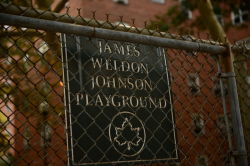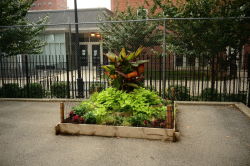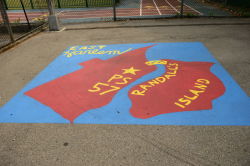James Weldon Johnson Playground
James Weldon Johnson Playground
James Weldon Johnson (1871-1938) was an African American intellectual of broad interests and accomplishments who was associated with the Harlem Renaissance. After graduating from Atlanta University in 1894, Johnson accepted the post of principal of the Stanton school in Jacksonville, Florida. The following year he founded the The Daily American, a newspaper dedicated to issues important to the black community. In 1897, he became the first African American to be accepted into the Florida Bar since Reconstruction. During these years, he also studied music and collaborated with his brother John Rosamond in the composition of several songs and operettas. In 1900, to commemorate Lincoln’s birthday, he wrote the poem “Lift Ev’ry Voice and Sing,” which was later adopted by the NAACP as the “Negro National Anthem.”
After a 1901 fire ravaged Jacksonville and burned down the Stanton school, Johnson moved to New York City with his brother. Here, he continued to write poetry and was able to devote more of his efforts to collaborating with Rosamond. The popularity of the Johnson brothers’ productions escalated, but James never abandoned his political pursuits and in 1906, through Booker T. Washington’s influence, he received a consular post from the Roosevelt administration. While serving at the Venezuelan consulate in Puerto Cabello, Johnson continued to write extensively, and in his three years there he wrote his novel The Autobiography of An Ex-Colored Man.
After a subsequent position with the Nicaraguan consulate, Johnson moved back to New York in 1913 and was made editor of the magazine New York Age, the preeminent African American daily newspaper of its time. He assumed the post of field secretary for the National Association for the Advancement of Colored People in 1917. Johnson compiled three anthologies of African American poetry and spirituals and continued to publish his own work even while devoting his career to activism. In 1930, he resigned his position to allow himself more time to write and was appointed to a professorship in Creative Writing at Fisk University in Nashville, Tennessee. At the time of his death, Johnson was regarded as a distinguished scholar and activist. He is buried in Green-Wood Cemetery in Brooklyn.
The James Weldon Johnson Playground was acquired in 1929 by purchase and condemnation and later named after the nearby James Weldon Johnson Housing Project. It has long served as a playground for the adjacent P.S. 57 elementary school and features a full basketball court, several half courts, and a handball court.
This site is part of Parks' Community Parks Initiative—a multi-faceted program to invest in under-resourced public parks and increase the accessibility and quality of parks throughout the five boroughs. This project reconstructed the public playground, sports courts and track, and jointly operated playground used by the adjacent school. This initiative ensures that the park remains an enjoyable neighborhood amenity for Harlem families for years to come.
Check out your park's Vital Signs
Clean & Safe
Green & Resilient
Empowered & Engaged Users
Share your feedback or learn more about how this park is part of a
Vital Park System










